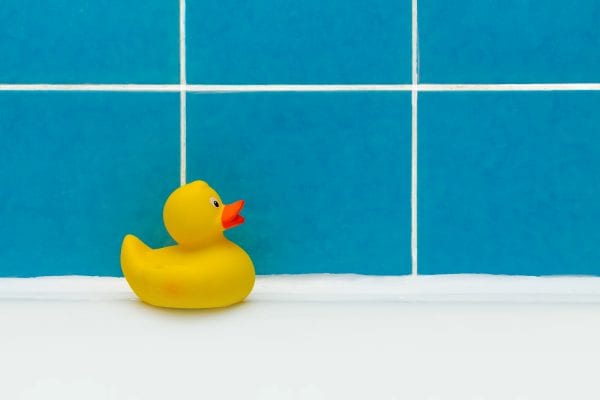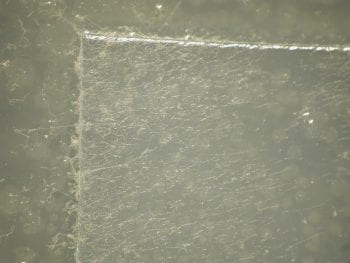We are a society that loves our plastic. With a global society that produces over 300 million tons of plastic every year, where ever you find humans, you find products made of plastic.
From medical devices, automotive parts to water storage tanks, we have found uses for oil-based polymers for the most intricate to simplest of tasks.
With plastic taking over 450 years to break down, it certainly seems the products are resilient. But does plastics' durable characteristics save them from microbes?
Can mold grow on plastic?
The short answer is an astounding yes!
The long answer? Mold needs a specific set of conditions to grow, and you might be surprised by what technology can do for us today!
[caption id="attachment_3394" align="aligncenter" width="600"]

Read our blog Black Mold in Your Water Bottle.
Why Does Mold Grow on Plastic?
Many people believe that mold cannot grow on plastic or polymer materials. Mold generally can't break down plastic easily.
However, plastic contains many additives, such as plasticizers, cellulose, lubricants, stabilizers, and colorants to help provide desired features, and these additives ARE very easy for mold to break down.
Once mold becomes established by breaking down the easily digested ingredients, the acids they produce as by-products of growth break down the resin into a more useable food source.
To learn more, read up on the ASTM G 21 test method that describes this process in greater detail.
What Does Mold Need to Grow on Plastic?
Mold is a broad term that covers a variety of species. Able to survive in the strangest of places, mold only has a few requirements to survive and thrive in any environment.
In addition to additives already embedded in the plastic itself, as mentioned above, food (dust, dirt, organic materials), moisture, and suitable temperature all provide enhanced conditions for mold growth to take hold.
While plastic might not be the preferred surface for sustaining mold growth, it can easily meet all the prerequisites if exposed to food, humidity, dirt, and dust.
These conditions vary widely between species. In fact, even the International Space Station (ISS) astronauts spend hours every week battling mold growth.
However, their fights have not gone unnoticed. Through their research, we have gained an indispensable look into the harsh environments of mold and its spores. The ISS scientists replicated the X-ray and UV exposure found around the space station and found spores surviving up to 100 gray worth of X-rays.
To put that in perspective, 5 gray is all that is needed to kill a person, while ½ gray is enough to induce radiation sickness.
So, is mold the next Terminator T-1000? Well, not for us resourceful humans!
Let's go through how to get your plastics back to new!
How to Clean Plastics
Step 1 - Debris
First things first – get rid of food, dust, mold, and other visible residues on or within your plastic. To do this, you will want to wear gloves and a mask to avoid inhaling or spreading fungal spores.
Using a sponge, cloth, or whatever suitable cleaning tool fits your product, wash away the debris with antimicrobial soap.
Step 2 – Cleaning Solution
Once all visible mold and particles have been removed from your plastic, we can start with the real cleaning!
Start by combining an effective cleaning solution. You can either go with diluted bleach (1 cup of bleach per 4 liters of water) or undiluted white vinegar. Don't worry about diluting the white vinegar. As we mentioned earlier, mold is a persistent pest, and vinegar needs its full acidic strength.
Both solutions will work when it comes to your fight against fungi, but there are particulars you should be aware of. Bleach is great for removing stains but can discolor plastic with enough concentration.
Vinegar, on the other hand, is perfect for removing odors and is safe for sensitive skin, but won't deal with stains as effectively as the bleach solution. As well, vinegar is safe for pets and young children.
WARNING: Never mix ammonia and bleach. The chemical reaction will result in toxic fumes dangerous to humans.
Submerge the plastic in your chosen solution for at least 15 minutes for bleach and 1 hour for vinegar. Baking soda can also be introduced to the vinegar if any residue is not removed with scrubbing. The oxidative reaction will "lift" off the plastic, making it easier to clean.
Rinse away solutions after soaking for the appropriate time.
Step 3 – Drying
For the last step, all you need to do is dry! But make sure this step is completed promptly, as a moist environment will only aid in the collection of mold spores, and your hard work would go to waste!
When Do You Need to Throw It Away?
Sometimes, you're not going to be able to clean your plastic to its fullest. But how do you know when it's time to replace? Well, it depends on your product.
Cutting boards are often most discussed when it comes to cleanliness, as these products come in contact with the food we eat.
Generally, the telltale indicator to replace your cutting board would be plentiful and deep knife grooves.
These are the perfect places for mold and bacteria to survive as it can often be challenging to scrub within the crevices.
Food containers that have come in contact with mold are often salvageable, albeit dependent on the age of your Tupperware.
If you can find cracks and scratches in the plastic, it won't be easy to ensure a thorough cleaning. However, you confidently toss your container in the trash at this point.
Other products, such as outdoor playhouses for children, toys, tools, and other plastic items around the home, are safe to clean, following our instructions above. Just make sure to rinse thoroughly and dry if an item will be in a child's possession.
[caption id="attachment_5335" align="aligncenter" width="600"]

Mold can be found growing in children's bath toys.
Antimicrobial Plastics
Cleaning isn't your first line of defense in the fight against household mold, so don't think you're alone!
Microbiologists and engineers have found spectacular ways to keep our homes fresher and cleaner for longer. By introducing antimicrobial agents during plastics manufacturing, we can effectively inhibit and reduce microbial growth on everyday products.
Here is an example of plastic after testing via the ASTM G21 antifungal test method.
[caption id="attachment_5330" align="alignright" width="350"]

[caption id="attachment_5327" align="alignleft" width="350"]

